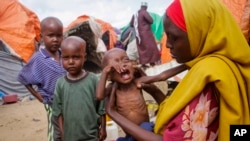The Food and Agriculture Organization warns some 6.7 million people in Somalia are likely to suffer from acute hunger this year, including more than 300,000 projected to face famine.
The FAO reports those at risk of famine are rural residents in the Baidoa and Burhakaba districts, as well as displaced people in the Baidoa town of Bay region in southern Somalia. FAO representative in Somalia Etienne Peterschmitt said malnutrition and mortality levels in that region already are at alarming levels.
"The repeated warnings have been clear," Peterschmitt said. "Act now or a famine will occur within the next few weeks. The drought situation is spreading at an alarming rate. More districts and regions are facing emergency levels of food insecurity as the accumulative effects of multiple failed rainy seasons take their toll."
Peterschmitt is from the Kabala district in Puntland State in northeast Somalia. He said he and colleagues are there to assess the impact of the drought on pastoral communities. He said the historic drought, high food prices and conflict have pushed food insecurity to catastrophic levels.
“The situation is fluid but is also fast-changing. However, trends dramatically resemble those seen in the famine that occurred in 2011,” said Peterschmitt. “The scale and magnitude of the drought emergency continues to worsen.”
The emergency is having a particularly devastating effect on children. UNICEF spokesman James Elder noted that at the time of the 2011 famine 340,000 children under age five required treatment for severe acute malnutrition. Today, he said, that number has gone up to 513,000 children who are at risk of death.
“Children are already dying. Our partners report that some stabilization centers are, in effect, full and critically ill children are having to receive treatment on the floor. We know, of course, that this is not just about nutrition, that severely malnourished children are, in fact, up to 11 times more likely to die from things like diarrhea and measles than well-nourished boys and girls.”
He noted both diseases are spiking in the region. Elder described the possibility that more than half-a-million children are facing preventable death as a pending nightmare not seen in this century.









